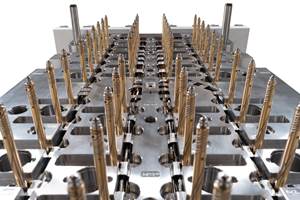The Innovation Advantage
For mold shops, new opportunity can come in the form of innovative products and processes.
In a well-established industry like moldmaking, the idea of innovation is a bit like the weather – everyone talks about it, but no one seems to be able to do anything about it. Wade Clark, President and CEO of Electroform Inc., is an exception to that rule.
Clark and Electroform have been receiving a lot of industry press recently for developing a proprietary rotary turntable for multi-shot molds. Clark designed the Electroform Turn Table to be +more robust than previously-existing turn tables; he also recognized the need for additional support of the platen, and developed a patent-pending support for the table and platen. The system will work on both tie-bar and tie bar-less machines.
Clark says that he had spent years developing and working with in-mold assembly of plastic parts in or with rotating mold and index plates, and was ready for a new challenge. “We reached out to customers looking for something to develop,” he says. “It came to our attention that there were failures with some of the existing turn tables on the market due to the weight loads required.”
When Electroform received an order for a multi-shot tool that was better suited for a rotary table than an index plate, the company saw an opportunity. “We offered to build a table and the mold under the contract. We then added customer-suggested options, gave them a new table and moved forward with the product line along with some heavy load testing,” Clark explains.
With the tagline “Imagination without limits” on the website home page, Electroform has identified innovation as a differentiator for its business. The Rockford, IL-based company specializes in molds for multi-shot and in-mold applications, product development, single-cavity prototypes to multi-cavity, high-volume hot runner molds and stack molds, as well as manufacturing cell development and mold validation for a variety of industries.
“There is a lot of innovation out there that people are hesitant to use—finding customers to take risks is a challenge,” says Clark. To help mitigate this perception of risk, it helps to first identify the applications for a new technology. “The best thing to do is present (new technology) to customers based on what you know their needs are,” he explains.
Some companies may use the recent economic downturn as an excuse to avoid the risks involved in new product development. Yet according to Clark, that’s not the biggest issue. “I see so many mold shops not sticking with their core competencies,” he says. “Yet I’ve seen companies that stuck with their core competencies and did very well in good times and bad.”
Clark does not limit the idea of “core competencies” to product mix or customer base; it includes a combination of the best use of people (labor) and equipment (capital investment). “The same goes for new developments,” he adds. “If you’re going to be doing something new, you need to make sure it’s going to work. You need people who can back it up with knowledge and experience.”
A new innovation cannot create business opportunities if no one knows how to use it. “The customer needs to have the workforce that can successfully implement new technology,” Clark says. “That kind of training is a workforce issue that the molding industry needs to address.”
Electroform’s success suggests that, for mold shops, new opportunity can come in the form of innovative products and processes. He adds, I didn’t create the first turntable, I refined it. I saw a need, and went from there.”
Related Content
Making Quick and Easy Kaizen Work for Your Shop
Within each person is unlimited creative potential to improve shop operations.
Read MoreMMT Chats: The Connection Between Additive Manufacturing Education and ROI
This MMT Chat continues the conversation with Action Mold and Machining, as two members of the Additive Manufacturing team dig a little deeper into AM education, AM’s return on investment and the facility and equipment requirements to implement AM properly.
Read MoreHow to Solve Hot Runner Challenges When Molding with Bioresins
A review of the considerations and adaptations required to design hot runners and implement highly productive injection molding operations.
Read MoreThe Role of Social Media in Manufacturing
Charles Daniels CFO of Wepco Plastics shares insights on the role of social media in manufacturing, how to improve the “business” side of a small mold shop and continually developing culture.
Read MoreRead Next
Reasons to Use Fiber Lasers for Mold Cleaning
Fiber lasers offer a simplicity, speed, control and portability, minimizing mold cleaning risks.
Read MoreHow to Use Strategic Planning Tools, Data to Manage the Human Side of Business
Q&A with Marion Wells, MMT EAB member and founder of Human Asset Management.
Read MoreAre You a Moldmaker Considering 3D Printing? Consider the 3D Printing Workshop at NPE2024
Presentations will cover 3D printing for mold tooling, material innovation, product development, bridge production and full-scale, high-volume additive manufacturing.
Read More




















